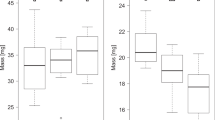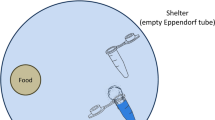Abstract
Neonicotinoid pesticides, such as the widely used compound imidacloprid, are suspected to impair cognitive capacity, behaviour, and fitness of a number of non-target species. We tested whether sublethal imidacloprid concentrations alter the foraging and aggression behaviour of two European ant species. Even though the nestmate-recruitment of Lasius niger was not affected by pesticide exposure, these ants required more time to become active and the number of foraging workers was lower than in sub-colonies not exposed to imidacloprid. In interspecific confrontations, imidacloprid increased the aggressiveness of a usually subordinate species (Lasius flavus) enormously (3.7-fold increase in average number of aggressive encounters), whereas they did not affect a subdominant species (L. niger) that severely (1.2-fold increase in average number of aggressive encounters). The high frequency of aggressive encounters of L. flavus vs. non-exposed L. niger workers, reduced their survival probability significantly down to 60 %. The observed behavioural alterations of the two ant species have the potential to impair their viability and co-occurrence with behaviourally dominate species due to a decreased exploitative competition and a reduced chance to locate and use resources before competitors. As competition is considered key in structuring ant communities, changes in aggressiveness are likely to alter established dominance hierarchies and thereby the dynamic and structure of ant communities.






Similar content being viewed by others
Abbreviations
- AI:
-
Active ingredient
- ANOVA:
-
Analysis of variance
- b:
-
Standard error of log
- Coxph:
-
Cox proportional hazard regression model
- df:
-
Degrees of freedom
- GLM:
-
Generalized linear model
- LF:
-
Lasius flavus
- LMM:
-
Linear mixed model
- LN:
-
Lasius niger
- noAI:
-
No active ingredient
- SE:
-
Standard error of the mean
- z:
-
Log-likelihood
References
Anon (2006) Draft assessment Report (DAR)—public version—Initial risk assessment provided by the rapporteur Member State Germany for the existing active substance imidacloprid. Volume 3, Annex B, B.8, February 2006
Arnan X, Gaucherel C, Andersen AN (2011) Dominance and species co-occurrence in highly diverse ant communities: a test of the interstitial hypothesis and discovery of a competition cascade. Oecologia 166:783–794
Arnan X, Cerdá X, Retana J (2012) Distinctive life traits and distribution along environmental gradients of dominant and subordinate Mediterranean ant species. Oecologia 170:489–500
Barbieri RF, Lester PJ, Miller AS, Ryan KG (2013) A neurotoxic pesticide changes the outcome of aggressive interactions between native and invasive ants. Proc R Soc B. doi:10.1098/rspb.2013.2157
Blacquiere T, Smagghe G, Van Gestel CAM, Mommaerts V (2012) Neonicotinoids in bees: a review on concentrations, side-effects and risk assessment. Ecotoxicology 21:973–992
Bonmatin JM, Moineau I, Charvet R, Collin ME, Fleche C, Bengsch ER (2005) Behavior of imidacloprid in fields. Toxicity for honey bees. In: Lichtfourse E, Schwarzbauer J, Robert D (eds) Environmental chemistry: green chemistry and pollutants in ecosystems. Springer, New York, pp 482–494
Bortolotti L, Montanari R, Marcelino J, Medrzycki P, Maini S, Porrini C (2003) Effect of sublethal imidacloprid doses on the homing rate and foraging activity of honey bees. Bull Insectol 56:63–67
Cerdá X, Arnan X, Retana J (2013) Is competition a significant hallmark of ant (Hymenoptera: Formicidae) ecology? Myrmecol News 18:131–147
Chen Z, Qu Y, Xiao D, Song L, Zhang S, Gao X, Desneux N, Song D (2015) Lethal and social-mediated effects of ten pesticide on the subterranean termite Reticulitermes speratus. J Pest Sci 88:741–751
Cordeiro EMG, Correa AS, Guedes RNC (2014) Insecticide-mediated shift in ecological dominance between two competing species of grain beetles. PLoS ONE 9:e100990
Desneux N, Decourtye A, Delpuech J-M (2007) The sublethal effects of pesticides on beneficial arthropods. Annu Rev Entomol 52:81–106
Devigne C, Detrain C (2002) Collective exploration and area marking in the ant Lasius niger. Insect Soc 49:357–362
Farooqui T (2013) A potential link among biogenic amines-based pesticides, learning and memory, and colony collapse disorder: a unique hypothesis. Neurochem Int 62:122–136
Gill RJ, Ramos-Rodriguez O, Raine NE (2012) Combined pesticide exposure severely affects individual- and colony-level traits in bees. Nature 491:105–108
Goulson D (2013) An overview of the environmental risks posed by neonicotinoid insecticides. J Appl Ecol 50:977–987
Guedes RNC, Smagghe G, Stark JD, Desneux N (2016) Pesticide-induced stress in arthropod pests for optimized integrated pest management programs. Annu Rev Entomol 61:3.1–3.20
IBM Corporation (2013) IBM SPSS statistics for Macintosh, Version 22.0. IBM Corp, Armonk
Jeschke P, Neuen R, Schindler M, Elbert A (2011) Overview of the status and global strategy for neonicotinoids. J Agric Food Chem 59:2897–2908
Matsuda K, Buckingham SD, Kleier D, Rauh JJ, Grauso M, Sattelle DB (2001) Neonicotinoids: insecticides acting on insect nicotinic acetylcholine receptors. Trends Pharmacol Sci 22:573–580
Mommaerts M, Reynders S, Boulet J, Besard L, Sterk G, Smagghe G (2010) Risk assessment for side-effects of neonicotinoids against bumblebess with and without impairing behavior. Ecotoxicology 19:207–215
Ozaki M, Wada-Katsuma A, Fujikawa K, Iwasaki M, Yokohari F, Satoji Y, Nisimura T, Yamaoka R (2005) Ant nestmate and non-nestmate discrimination by a chemosensory sensillum. Science 309:311–314
Parr CL (2008) Dominant ants can control assemblage species richness in a South African savanna. J Anim Ecol 77:1191–1198
Pontin J (1961) Population stabilization and competition between the ants Lasius flavus (F.) and L. niger (L.). J Anim Ecol 30:47–54
Reitz SR, Trumble JT (2002) Competitive displacement among insects and arachnids. Annu Rev Entomol 47:435–465
Riley JR, Greggers U, Smith AD, Reynolds DR, Menzel R (2005) The flight paths of honeybee recruited by the waggle dance. Nature 435:205–207
Rodriguez-Cabal MA, Stuble KL, McCormick GL, Juric I, Dunn RR, Sanders NJ (2013) Tradeoffs, competition, and coexistence in eastern deciduous forest ant communities. Oecologia 171:981–992
SAS Institute (2013) JMP® for Macintosh, Version 11.1.1. Cary, SAS Institute Inc
Savolainen R, Vepsäläinen K, Wuorenrinne H (1989) Ant assemblages in the taiga biome: testing the role of territorial wood ants. Oecologia 81:481–486
Seifert B (2007) Die Ameisen Mittel- und Nordeuropas. Lutra, Görlitz
Sih A, Cote J, Evans M, Fogarty S, Pruitt J (2012) Ecological implications of behavioural syndromes. Ecol Lett 15:278–289
Suarez AV, Tsutsui ND, Holway DA, Case TJ (1999) Behavioral and genetic differentiation between native and introduced populations of the Argentine ant. Biol Invasions 1:43–53
Sur R, Stork A (2003) Uptake, translocation and metabolism of imidacloprid in plants. Bull Insectol 56:35–40
R Development Core Team (2013) R: A language and environment for statistical computing. 3.0.1 ed. Vienna, R foundation for statistical computing
Therneau T (2013) A package for survival analysis in S. R package version 2.37-4
Thorne BL, Breisch NL (2001) Effects of sublethal exposure to imidacloprid on subsequent behavior of subterranean termite Reticulitermes virginicus (Isoptera: Rhinotermitidae). J Econ Entomol 94:492–498
Tomé HVV, Martins GF, Lima MAP, Campos LAO, Guedes RNC (2012) Imidacloprid induced impairment of mushroom bodies and behavior of the native stingless bee Melipona quadrifasciata anthidioides. PLoS ONE 7:e38406
Vepsäläinen K, Pisarski B (1982) Assembly of island ant communities. Ann Zool Fennici 19:327–335
Whitehorn PR, O`Conner S, Wackers FL, Goulson D (2012) Neonicotinoid pesticide reduces bumblebee colony growth and queen production. Science 20(336):351–352
Williamson SM, Wright GA (2013) Exposure to multiple cholinergic pesticides impairs olfactory learning and memory in honeybees. J Exp Biol 216:1799–1807
Wolf M, Weissing FJ (2012) Animal personalities—consequences for ecology and evolution. Trends Ecol Evol. doi:10.1016/j.tree.2012.05.001
Yang EC, Ciiuang YC, Ciien YL, Ciiang L (2008) Abnormal foraging behaviour induced by sublethal dosage of imidacloprid in the honey bee (Hymenoptera:Apidae). J Econ Entomol 107:1743–1748
Acknowledgments
We thank Bernhard Seifert, Museum of Natural History Senckenberg, for the determination of the ant species. We are also grateful to Katharina Peschke for helpful comments on the manuscript and to Patrick Schulz, Marc Bilton, Simon Schwarz (all Tübingen University), and Margit Einsiedler (Augsburg University) for their support during various stages of this work.
Funding
This research received no specific grant from any funding agency in the public, commercial or not-for-profit sectors.
Author information
Authors and Affiliations
Corresponding author
Ethics declarations
Conflict of interest
The authors declare that they have no conflict of interest.
Rights and permissions
About this article
Cite this article
Thiel, S., Köhler, HR. A sublethal imidacloprid concentration alters foraging and competition behaviour of ants. Ecotoxicology 25, 814–823 (2016). https://doi.org/10.1007/s10646-016-1638-6
Accepted:
Published:
Issue Date:
DOI: https://doi.org/10.1007/s10646-016-1638-6




